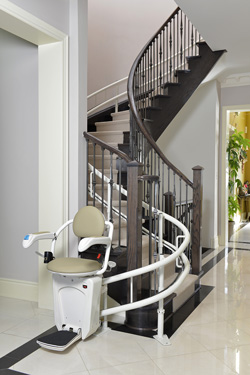How Stair Lifts Work
A stair lift is basically a chair that travels along and rail or track that is mounted to a stairway.
There is a motor within the base of the chair that is usually powered by a battery also within the base of the chair. The stair lift motor turns a gear that is meshed into a geared strip on the track or rail. When the gear turns the chair is moved along the geared strip. When the motor turns the gear the chair moves one direction, when the motor's direction is reversed the chair moves the opposite way.
Call/Send switches are used to move the stair lift chair without anyone being on it. This is particularly helpful if two people use the lift and the lift is at the opposite end of the track when a user wants to use it. the user simply calls the lift to come to them using a call/send switch. Another use of call/send switch is to send the lift away after use. Some people don't like the look of the lift parked in the main living area of the home and will send it to the opposite end when not in use. They simply call it back when needed.
Stair Lift Components
Although the design and style of stair lifts will vary between manufacturers they all have some basic components common to them all:
- Track or Rail - The stair lift track supports the chair, provides a mechanism (usually a geared strip) to propel the chair and guides it up and down the stairway just as a train track guides a train.
- Track Overruns - Some stair lifts offer the option of an overrun at either the top of the track, bottom of the track or both. The purpose of a stair lift track overrun is to move the user away from the stairway to safely access or dismount the stair lift in a location where, if they fall, they won't fall on the stairs.
- Power supply - While most stair lifts are battery operated today all model will require a power supply to either charge the battery or power the unit directly in the case of non-battery powered units. Non-battery powered stair lifts draw a lot of power and normally require a dedicated circuit.
- Call/Send Controls - Call/Send controls are normally mounted on the wall near each end of the stair lift track to provide a way for a user to call the chair to them or send it away when not needed. They can be either wireless or wired to the lift depending on the model.
- Seat - The stair lift seat is simply a seat for the user to sit on while using the lift. Depending on the model it may swivel at the top and/or bottom of the track and will normally fold up out of the way when not in use.
- Seat Belt - As in a car the stair lift seat belt is intended to hold the user safely seated on the seat while the lift is in use.
- Foot Rest - The foot rest of the stair lift is a safety feature to prevent the the users feet from hitting the steps while using the lift and a comfort feature to support the user's feet when sitting on the seat. The foot rest will have switches built into them to stop the lift should it hit anything on the stairway and will flip up out of the way when the lift is not in use.
- Motor - The motor that drives a stairlift chair along the track is found in the base of the seat.
- Transmission - Because the motor rotates at too high a speed to safely propel the stair lift up the track at type of transmission is employed to reduce the speed while increasing the power available.
- Battery Charger - Battery powered stair lifts must have a charger of some sort to keep the battery charged. The chargers are normally found under the track or near one end of the track. The charger works automatically with no action needed by the user.
- Battery - The batteries used in stair lifts are fairly expensive and found within the base of the seat near the motor. They will need to be replaced at some time but their life span is measured in years and thier replacement should not be a big concern.


 Online Vendors
Online Vendors  US Online Vendors
US Online Vendors 


